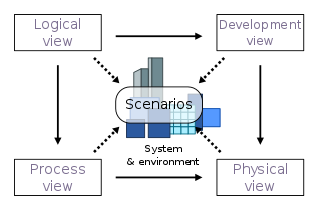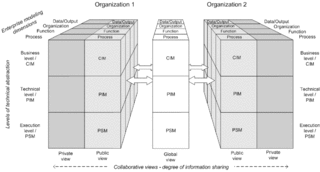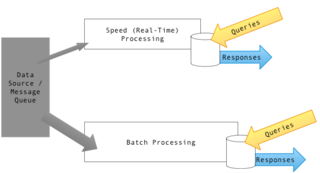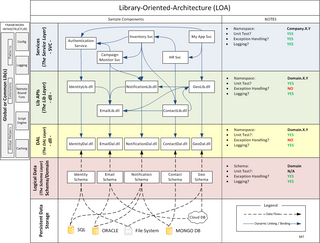 W
WSoftware architecture refers to the fundamental structures of a software system and the discipline of creating such structures and systems. Each structure comprises software elements, relations among them, and properties of both elements and relations. The architecture of a software system is a metaphor, analogous to the architecture of a building. It functions as a blueprint for the system and the developing project, laying out the tasks necessary to be executed by the design teams.
 W
W4+1 is a view model used for "describing the architecture of software-intensive systems, based on the use of multiple, concurrent views". The views are used to describe the system from the viewpoint of different stakeholders, such as end-users, developers, system engineers, and project managers. The four views of the model are logical, development, process and physical view. In addition, selected use cases or scenarios are used to illustrate the architecture serving as the 'plus one' view. Hence, the model contains 4+1 views:Logical view: The logical view is concerned with the functionality that the system provides to end-users. UML diagrams are used to represent the logical view, and include class diagrams, and state diagrams. Process view: The process view deals with the dynamic aspects of the system, explains the system processes and how they communicate, and focuses on the run time behavior of the system. The process view addresses concurrency, distribution, integrator, performance, and scalability, etc. UML diagrams to represent process view include the sequence diagram, communication diagram, activity diagram. Development view: The development view illustrates a system from a programmer's perspective and is concerned with software management. This view is also known as the implementation view. It uses the UML Component diagram to describe system components. UML Diagrams used to represent the development view include the Package diagram. Physical view: The physical view depicts the system from a system engineer's point of view. It is concerned with the topology of software components on the physical layer as well as the physical connections between these components. This view is also known as the deployment view. UML diagrams used to represent the physical view include the deployment diagram. Scenarios: The description of an architecture is illustrated using a small set of use cases, or scenarios, which become a fifth view. The scenarios describe sequences of interactions between objects and between processes. They are used to identify architectural elements and to illustrate and validate the architecture design. They also serve as a starting point for tests of an architecture prototype. This view is also known as the use case view.
 W
WArchiMate is an open and independent enterprise architecture modeling language to support the description, analysis and visualization of architecture within and across business domains in an unambiguous way.
 W
WThe Architecture of Interoperable Information Systems (AIOS) is a reference architecture for the development of interoperable enterprise information systems. If enterprises or public administrations want to engage in automated business processes with other organizations, their IT systems must be able to work together, i.e. they need to be interoperable. The AIOS represents a generic building plan for these organizations to develop interoperable information systems by systematically adjusting and extending their internal information systems. The AIOS was described in a doctoral thesis and is based on the results of various research projects on interoperability. It is independent from specific products or vendors but describes generically the different layers, views, relationships and technical means needed to efficiently establish interoperable information systems. To this aim it combines concepts from service-oriented architecture, Collaborative Business and Business Process Modelling. It can be seen as complementary to ARIS, a well-known architecture for internal information systems and business processes.
 W
WA command-line interface (CLI) processes commands to a computer program in the form of lines of text. The program which handles the interface is called a command-line interpreter or command-line processor. Operating systems implement a command-line interface in a shell for interactive access to operating system functions or services. Such access was primarily provided to users by computer terminals starting in the mid-1960s, and continued to be used throughout the 1970s and 1980s on VAX/VMS, Unix systems and personal computer systems including DOS, CP/M and Apple DOS.
 W
WComponent-based software engineering (CBSE), also called components-based development (CBD), is a branch of software engineering that emphasizes the separation of concerns with respect to the wide-ranging functionality available throughout a given software system. It is a reuse-based approach to defining, implementing and composing loosely coupled independent components into systems. This practice aims to bring about an equally wide-ranging degree of benefits in both the short-term and the long-term for the software itself and for organizations that sponsor such software.
 W
WComposition over inheritance in object-oriented programming (OOP) is the principle that classes should achieve polymorphic behavior and code reuse by their composition rather than inheritance from a base or parent class. This is an often-stated principle of OOP, such as in the influential book Design Patterns (1994).
 W
WIn software engineering, coupling is the degree of interdependence between software modules; a measure of how closely connected two routines or modules are; the strength of the relationships between modules.
 W
WIn computing, the desktop metaphor is an interface metaphor which is a set of unifying concepts used by graphical user interfaces to help users interact more easily with the computer. The desktop metaphor treats the computer monitor as if it is the top of the user's desk, upon which objects such as documents and folders of documents can be placed. A document can be opened into a window, which represents a paper copy of the document placed on the desktop. Small applications called desk accessories are also available, such as a desk calculator or notepad, etc.
 W
WAn enterprise service bus (ESB) implements a communication system between mutually interacting software applications in a service-oriented architecture (SOA). It represents a software architecture for distributed computing, and is a special variant of the more general client-server model, wherein any application may behave as server or client. ESB promotes agility and flexibility with regard to high-level protocol communication between applications. Its primary use is in enterprise application integration (EAI) of heterogeneous and complex service landscapes.
 W
WEvent storming is a workshop-based method to quickly find out what is happening in the domain of a software program. Compared to other methods it is extremely lightweight and intentionally requires no support by a computer. The result is expressed in sticky notes on a wide wall. The business process is "stormed out" as a series of domain events which are denoted as orange stickies. It was invented by Alberto Brandolini in the context of domain-driven design (DDD). Event storming can be used as a means for business process modeling and requirements engineering. The basic idea is to bring together software developers and domain experts and learn from each other. To make this learning process easier, event storming is meant to be fun. The name was chosen to show that the focus should be on the domain events and the method works similar to brainstorming or agile modeling's model storming.
 W
WEVO/CB is a distributed object system that is constructed on top of publish/subscribe event systems. This design decision implies modeling method calls as events and subscriptions over the underlying messaging middleware.
 W
WIn systems engineering, software engineering, and computer science, a function model or functional model is a structured representation of the functions within the modeled system or subject area.
 W
WThe graphical user interface is a form of user interface that allows users to interact with electronic devices through graphical icons and audio indicator such as primary notation, instead of text-based user interfaces, typed command labels or text navigation. GUIs were introduced in reaction to the perceived steep learning curve of command-line interfaces (CLIs), which require commands to be typed on a computer keyboard.
 W
WIn the design of Java Web applications, there are two commonly used design models, referred to as Model 1 and Model 2.
 W
WJSP Model 2 is a complex design pattern used in the design of Java Web applications which separates the display of content from the logic used to obtain and manipulate the content. Since Model 2 drives a separation between logic and display, it is usually associated with the model–view–controller (MVC) paradigm. While the exact form of the MVC "Model" was never specified by the Model 2 design, a number of publications recommend a formalized layer to contain MVC Model code. The Java BluePrints, for example, originally recommended using EJBs to encapsulate the MVC Model.
 W
WLambda architecture is a data-processing architecture designed to handle massive quantities of data by taking advantage of both batch and stream-processing methods. This approach to architecture attempts to balance latency, throughput, and fault-tolerance by using batch processing to provide comprehensive and accurate views of batch data, while simultaneously using real-time stream processing to provide views of online data. The two view outputs may be joined before presentation. The rise of lambda architecture is correlated with the growth of big data, real-time analytics, and the drive to mitigate the latencies of map-reduce.
 W
WIn software engineering, a Library Oriented Architecture (LOA) is a set of principles and methodologies for designing and developing software in the form of reusable software libraries constrained in a specific ontology domain. LOA provides one of the many alternate methodologies that enable the further exposure of software through a service-oriented architecture. Library orientation dictates the ontological boundaries of a library that exposes business functionality through a set of public APIs. Library Oriented Architecture further promotes practices similar to Modular Programming, and encourages the maintenance of internal libraries and modules with independent internal open-source life-cycles. This approach promotes good software engineering principles and patterns such as separation of concerns and designing to interfaces as opposed to implementations.
 W
WMagisto is a technology company founded in 2009 with a focus to provide artificial intelligence (AI) technology in order to make video editing fast and simple. It produces an online video editor of the same name for automated video editing and production aimed at consumers and businesses. The company was acquired by Vimeo in 2019 for an estimated US$200 million .
 W
WMySocialCloud is a cloud-based bookmark vault and password website that allows users to log into all of their online accounts from a single, secure website. The company’s investors include Sir Richard Branson, Insight Venture Partners’ Jerry Murdock, and PhotoBucket founder Alex Welch. The company and its founders have been featured in TechCrunch and The Huffington Post.
 W
WPresentation–abstraction–control (PAC) is a software architectural pattern. It is an interaction-oriented software architecture, and is somewhat similar to model–view–controller (MVC) in that it separates an interactive system into three types of components responsible for specific aspects of the application's functionality. The abstraction component retrieves and processes the data, the presentation component formats the visual and audio presentation of data, and the control component handles things such as the flow of control and communication between the other two components.
 W
WQP is a family of lightweight, open source software frameworks for building responsive and modular real-time embedded applications as systems of cooperating, event-driven active objects (actors).
 W
WA shared disk architecture (SD) is a distributed computing architecture in which the nodes share same disk devices but each node has its own private memory. The disks have active nodes which all share memory in case of any failures. In this architecture the disks are accessible from all the cluster nodes. This architecture has quick adaptability to the changing workloads. It uses robust optimization techniques. It contrasts with shared nothing architecture, in which all nodes have sole access to distinct disks. Multiple processors can access all disks directly via intercommunication network and every processor has local memory.
 W
WA web application is application software that runs on a web server, unlike computer-based software programs that are run locally on the operating system (OS) of the device. Web applications are accessed by the user through a web browser with an active network connection. These applications are programmed using a client–server modeled structure—the user ("client") is provided services through an off-site server that is hosted by a third-party. Examples of commonly-used web applications include: web-mail, online retail sales, online banking, and online auctions.